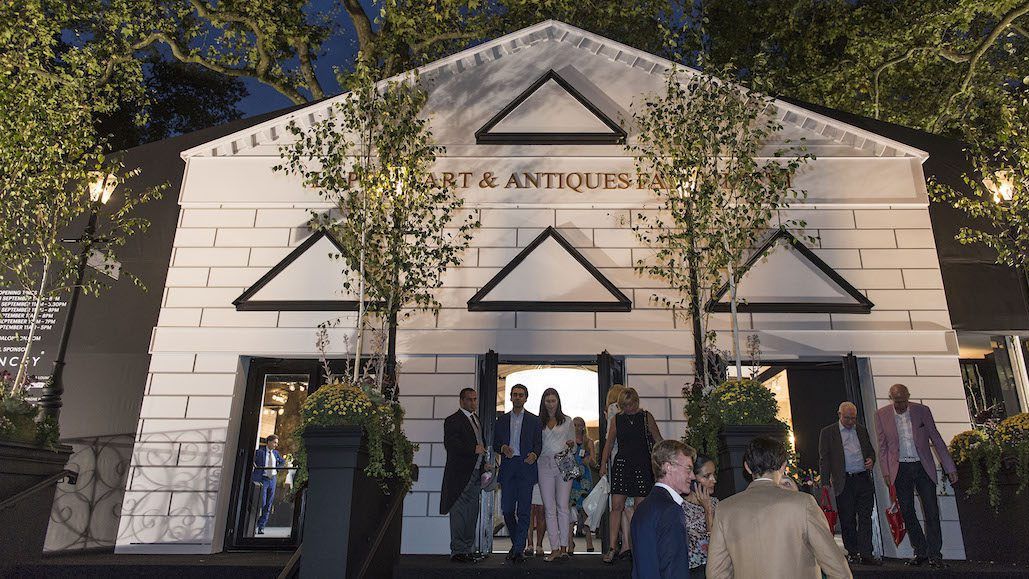

Our picks from the LAPADA art fair
The best moments at this year's Lapada art fair
Words: Gentleman's Journal
The LAPADA Art & Antiques Fair opens for its eighth year to the suitably breathtaking surrounds of Berkeley Square, Mayfair. Sponsored by Delancey, the LAPADA Fair offers an unmissable opportunity to source and buy some of the world’s most coveted works of art, antiques, design and decorative arts. It opens tomorrow and runs until Sunday 18th September 2016, marking the start of London’s fashionable Autumn art season.
Over 100 members of LAPADA the Association of Art & Antiques Dealers, all experts in their fields, will exhibit an exquisite range of works across an array of disciplines including jewellery, furniture, carpets, tapestries, antiquities, clocks, ceramics, silver and fine art. As approachable as they are knowledgeable, dealers are always pleased to share insights into the works they offer and their provenance.
With each exhibitor adhering to a strict Code of Practice and an expert committee of 70 specialists assigned the task of pre-vetting every piece individually, the absolute authenticity of all work can be relied upon.
As a longstanding event in the art and antiques calendar the LAPADA Fair has continued to attract private collectors and interior designers from all over the world. The quality and diversity of pieces offered has resulted in consistently high attendance rates, with over 20,000 visitors in 2015. Showcasing works that range from £500 to £500,000, the fair appeals to the most distinguished of collectors as well as first-time buyers.
LAPADA the Association of Art & Antiques Dealers will be principally sponsored by the specialist real estate investment and advisory company, Delancey, for the third consecutive year. This year, through its charity evening, the Fair will be supporting The ARNI Institute, an organisation which provides support to stroke survivors around the UK. The Executive Committee for the event includes Lord Lingfield, Lord Chadlington, and broadcaster Andrew Marr.
Beedham Antiques, Stand B17
A late Romanesque Caen stone capital featuring ‘Labours Of The Months’ imagery. Most likely Normandy or possibly Anglo Norman, circa 1150 – 1250.
Brian Watson Antique Glass, Stand B37
An engraved Cycle Club facet stem wine glass engraved for Richard Price-Thelwall, circa 1770.
Richard Price Thelwall (1736 – 1782) of Rhilwais, Merioneth, was MP for Beaumaris, 1754 – 1775 and High Sheriff of Denbigh, 1770.
The Cycle Club was a Welsh Jacobite club revived in 1770 by Sir Watkyn Williams Wynn, Bart. and a group of like-minded Welsh landowners. Sir Watkyn’s ancestor, also called Sir Watkin, founded the original club in 1715 in support of the Old Pretender and meetings had also taken place during the period of the Young Pretender, Prince Charles Edward Stuart.
The glass shown here is one of four being exhibited by Brian Watson Antique Glass. The other three have the names of Richard Parry Price, T. Bycott and P.Davies engraved on them. They are part of a group of thirteen glasses used by members of the Cycle Club between the 2nd July 1770 and the 8th July 1772. This group descended from the Vaughan family of Nannau in North Wales. Four of them are now in the National Museum of Wales. The four to be exhibited represent a part of the Jacobite support movement which continued after the collapse of the rebellion in 1746.
The glasses were used at dinners hosted by each member of the club. It is believed that a set of was kept by each of twelve named hosts.
Mark Goodger, Stand B12
Henry Clay Tea Caddies, circa: 1790
A rare pair of George III papier mache oval tea caddies, attributed to Henry Clay. Decorated using the grisaille method, with classical figures in the Etruscan style. Each caddy is decorated with bands of classical anthemions, one has a chevron pattern, the other a floral decoration on the lid. This was done purposely, probably to enable the caddies’ owners to distinguish which caddy contained green or black tea. Each features a solid silver handle stamped “HC”, bearing the assay office mark for Birmingham. The gilt metal-rimmed tops open to reveal tin foil lined interiors, which retain their original silver-handled floating lids.
The caddies originally formed part of the display in the Etruscan Dressing Room at the famous ‘palace of palaces’, Osterley Park in Isleworth, designed by the architect Robert Adam.
Henry Clay produced items ranging from small caddies, trays, knife boxes and dressing cases, to small pieces of japanned furniture. Clay moved to London from Birmingham, first establishing a workshop at 18 King Street in Covent Garden, where his array of clients included the Royal Family, eventually becoming ‘Japanner in Ordinary to His Majesty and His Royal Highness the Prince of Wales’.
Hatch well Antiques, Stand B31
A ‘Mira Flygel’ PH grand piano designed in 1931 by Poul Hennigsen, for Andreas Christensen. Made in 1933 by Andreas Christensen Flygler of Copenhagen.
Andreas Christensen (AC) started producing pianos in 1912, the company embraced modern Danish design and worked with the best contemporary architects, such as Torben Christensen and Alfred Skjøt-Pedersen. AC pianos repeatedly collaborated with the architect and designer Poul Henningsen who designed this grand piano.
Poul Henningsen (9 September 1894 – 31 January 1967), Danish author, architect and critic, was one of the leading figures of the cultural life of Denmark between the World Wars. In Denmark, he is often referred to simply as PH.
This piano is known for its open design and the ability to be able to see the different parts of the action work, allowing the enjoyment of watching the hammers and dampers move whilst the piano is being played, as opposed to being enclosed in a traditional black wooden box. During the design process Poul Henningsen, consulted the Danish Jazz pianist Leo Mathiesen. Mathiesen complained that the solid lid of his piano made it hard to see his bass player during performances, so Henningsen designed the Perspex lid to solve the problem. Later Henningsen was quoted saying that “also you remove a violin from its case before you played it”.
Holly Johnson Antiques, Stand B33
A Fornasetti “Malachite” Trumeau Cabinet, by Ateliers Fornasetti. Lithographically printed and hand coloured wood with lacquer finish.The cabinet marked with atelier label to upper drawer and stamped to lower side. No1 of 3. 2010. Italy. 218cm high x81cm wide x 40.5cm deep.
I. Franks, Stand A5
They are a life size pair of pheasants, made in Paris circa 1935 by Maison Eschwege, and are first quality silver. They are superbly made with lifelike detailing and hinged wings. The male pheasant is 30 inches long, 8 inches high and weighs 56 troy oz. The female pheasant is 28 inches long, 10.25 inches high and weighs 50 troy oz. They are quite enormous and together weigh a substantial 106 troy oz. Pheasant models are often much smaller in size, and models of this size are typically very modern and not as nicely made. It is incredibly rare to find old models of a similar size and quality.
Fairhead Fine Art Limited T/A Images, Stand B19
Salvador Dali (1904 – 1989), Futbol, original drawing, pencil on cardboard, 1979, signed and dated “GDALI 1979”, 400 x 400 mms (15 3/4” x 15 3/4”)
This comes from a series called “Sports” which Dali made for the Olympic Games and our drawing is a study for the Medal made for the American Olympic Committee. Dali made a series of studies of Sports including Golf, Swimming and Tennis. Sold with the above, and embedded in the frame (obverse and reverse) are two copies of the medal for which the drawing is a study. It can immediately be seen how close is the study to the finished product.
Kevin Page Oriental Art, Stand A4
It is an almost life sized Japanese bronze Samurai warrior, dating from circa 1900. It is 185cm to the top of his helmet (including base) and 214cm high (including base) if you measure right to the top of his Naginata (long handled blade).
Mary Cooke Antiques, Stand B47
Harriott Beauclerk, Duchess of St Albans. A highly important George III water jug most likely used in a dressing room or boudoir. Made in London in 1818 by John Edward Terrey.
This very unusual piece has a baluster form and rises to an everted rim, decorated with gadrooning. The front of the main body is engraved with the contemporary script initials HStA for Harriott St Albans, all below the Coronet of a Duchess. The neck is also engraved with a second set of script initials, these being, AGBC, for Angela Georgina Burdett Coutts, 1st Baroness Burdett Coutts, who was the heiress of the Duchess of St. Albans. The jug was most probably for hot water and would have been used in either a dressing room or boudoir. It is most unusual to find this type of Jug being made in silver, as they were nearly always made from porcelain. As the Duchess of St Albans was one of the wealthiest women in England at this date, it is no surprise that it is made of silver such was her position in society.
Phillip Mould Portrait Miniatures, Stand A11
WILLIAM GRIMALDI RA (1751-1830)
Arthur Wellesley, 1st Duke of Wellington (1769-1852), in field marshal’s uniform, 1814
Watercolour on ivory Rectangular,71⁄2×53⁄4in(19×14.5cm)
Signed and dated: ‘1814/ W. Grimaldi’
Provenance: ‘Captain’ Edwin Stacey; By family descent
Exhibited: Probably the version exhibited Royal Academy 1815, no.555


